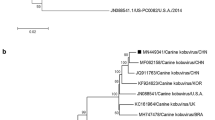Abstract
In the present study, we have cloned and sequenced the nearly-full-length genome of minute virus of canines (MVC), SH26, in China. The genome of MVC, 5,132 nucleotides (nts) in length, contains three open reading frames (ORFs), which are 2,325-bp of NS1, 561-bp of NP1 and 2,112-bp of VP1/VP2 encoding three proteins of 774, 186 and 703 residues, respectively. Predicted amino acids sequence of NS1 of MVC has 44% identity with human bocavirus (HBoV) and human boacvirus 2 (HBoV2), NP1 has 48 and 45% identity with HBoV and HBoV2, VP1/VP2 has 45 and 46% identity with HBoV and HBoV2, respectively. Phylogenetic analysis showed that the present Chinese MVC strain was also closely clustered with the previous American and Japanese MVC isolates, and MVCs formed a different branch together with bovine parvovirus and HBoVs from other parvoviruses classified into Parvovirinae.

Similar content being viewed by others
References
Allander T, Tammi MT, Eriksson M, Bjerkner A, Tiveljung-Lindell A, Andersson B (2005) Cloning of a human parvovirus by molecular screening of respiratory tract samples. Proc Natl Acad Sci USA 102:12891–12896
Sun Y, Chen AY, Cheng F, Guan W, Johnson FB, Qiu J (2009) Molecular characterization of infectious clones of the minute virus of canines reveals unique features of bocaviruses. J Virol 83:3956–3967
Albuquerque MC, Rocha LN, Benati FJ et al (2007) Human bocavirus infection in children with gastroenteritis, Brazil. Emerg Infect Dis 13:1756–1758
Cheng WX, Jin Y, Duan ZJ et al (2008) Human bocavirus in children hospitalized for acute gastroenteritis: a case–control study. Clin Infect Dis 47:161–167
Lau SK, Yip CC, Que TL et al (2007) Clinical and molecular epidemiology of human bocavirus in respiratory and fecal samples from children in Hong Kong. J Infect Dis 196:986–993
Vicente D, Cilla G, Montes M, Pérez-Yarza EG, Pérez-Trallero E (2007) Human bocavirus, a respiratory and enteric virus. Emerg Infect Dis 13:636–637
Schildgen O, Muller A, Allander T, Mackay IM, Volz S, Kupfer B, Simon A (2008) Human bocavirus: passenger or pathogen in acute respiratory tract infections? Clin Microbiol Rev 21:291–304
Kapoor A, Slikas E, Simmonds P, Chieochansin T, Naeem A, Shaukat S, Alam MM, Sharif S, Angez M, Zaidi S, Delwart E (2009) A newly identified bocavirus species in human stool. J Infect Dis 199:196–200
Binn LN, Lazar EC, Eddy GA, Kajima M (1970) Recovery and characterization of a minute virus of canines. Infect Immun 1:503–508
Schwartz D, Green B, Carmichael LE, Parrish CR (2002) The canine minute virus (minute virus of canines) is a distinct parvovirus that is most similar to bovine parvovirus. Virology 302:219–223
Tattersall P (2006) The evolution of parvovirus taxonomy. In: Kerr J, Cotmore SF, Bloom ME, Linden RM, Parrish CR (eds) Parvoviruses. Hodder Around, London, pp 5–14
Carmichael LE, Schlafer DH, Hashimoto A (1991) Pathogenicity of minute virus of canines (MVC) for the canine fetus. Cornell Vet 81:151–171
Mochizuki M, Hashimoto M, Hajima T, Takiguchi M, Hashimoto A, Une Y, Roerink F, Ohshima T, Parrish CR, Carmichael LE (2002) Virologic and serologic identification of minute virus of canines (canine parvovirus type1) from dogs in Japan. J Clin Microbiol 40:3993–3998
Pratelli A, Buonavoglia D, Tempesta M, Guarda F, Carmichael L, Buonavoglia C (1999) Fatal canine parvovirus type-1 infection in pups from Italy. J Vet Diagn Invest 11:365–367
Jang HK, Tohya Y, Han KY, Kim TJ, Song CS, Mochizuki M (2003) Seroprevalence of canine calicivirus and canine minute virus in the Republic of Korea. Vet Rec 153:150–152
Ohshima T, Kishi M, Mochizuki M (2004) Sequence analysis of an Asian isolate of minute virus of canines (canine parvovirus type 1). Virus Genes 29:291–296
Author information
Authors and Affiliations
Corresponding author
Additional information
T. L. Shan and L. Cui contributed equally to this work.
Rights and permissions
About this article
Cite this article
Shan, T.L., Cui, L., Dai, X.Q. et al. Sequence analysis of an isolate of minute virus of canines in China reveals the closed association with bocavirus. Mol Biol Rep 37, 2817–2820 (2010). https://doi.org/10.1007/s11033-009-9831-9
Received:
Accepted:
Published:
Issue Date:
DOI: https://doi.org/10.1007/s11033-009-9831-9




